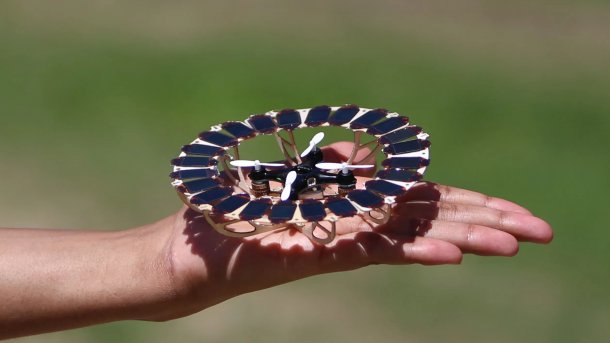Researchers develop perovskite solar cells for energy-autonomous drone operation
Inspection drones, for example, should remain in the air for as long as possible. Perovskite solar modules could be the key for a solution.

The JKU's mini drone. The perovskite solar modules are arranged in a ring.
(Bild: JKU)
A research team at Johannes Kepler University Linz (JKU) has developed lead halide perovskite solar cells that can also charge the batteries of mini quadcopters in flight and, if further developed, will enable energy-autonomous operation. The perovskite solar modules are very thin and light.
The researchers tested various combinations of alpha-methylbenzylammonium iodide (MBA) in the uppermost perovskite absorber layer. The polymer mixture of two ionomers PEDOT:PSS (polypolystyrene sulfonate) took over the functions of hole transport and the electrode. An MBA combination with cesium resulted in the longest service life, the scientists write in their scientific paper "Flexible quasi-2D perovskite solar cells with high specific power and improved stability for energy-autonomous drones", published in Nature Energy.
The electron transport layer consists of phenyl-C61-butyric acid methyl ester (PCBM) with a titanium oxide interlayer and an upper metal contact. This can be made of gold, chromium-gold or, at low cost, aluminum.
As a result, the researchers created a transparent, conductive oxide-free polymer film with a thickness of 1.4 μm, which is covered by a 100 nm thick aluminum layer applied by atomic layer deposition (ALD). This is intended to protect against moisture and gases from the outside, as encapsulation would unnecessarily increase the thickness and weight of the solar module. In contrast, it remains light and flexible.
Researchers at the JKU developed two solar cells with a size of 0.1 cm² and 1.0 cm². The smaller version has an open circuit voltage of 1.13 V, a short-circuit current density of 21.6 mA per cm², a fill factor of 74.3 percent and an efficiency of 18.1 percent. The best cells achieved an open-circuit voltage of 1.15 V, a fill factor of 78 percent and an efficiency of 20.1 percent.
For the four-engine electric drone, the scientists initially used the larger-area variant. It achieved an average open circuit voltage of 1.11 V, a short circuit density of 20 mA per cm², a fill factor of 65.9 percent and an efficiency of 14.7 percent. The best cells achieved a slightly higher efficiency of 16.3 percent.
For the solar module of the drone, which weighs just 13 g, the researchers connected 24 of the 1 cm² solar cells together. The weight of the solar module is only one 400th of the total weight of the quadcopter, as the scientists write.
Perovskite solar modules in field trials
The scientists tested the drone outdoors in order to expose it to real-life conditions and test its endurance flight capability. After 50 hours, the solar modules still achieved 74 percent of their original output with continuous maximum power point tracking (MPPT) in ambient air. The variant with smaller solar cells even achieved 90 percent. The performance achieved by the perovskite solar modules was confirmed by an external laboratory, the scientists write.
The researchers see the result of their research as a step towards the development of a charging system for drones that can be operated permanently. Terrestrial applications of the perovskite solar cells are also conceivable.
The research team is already working on improvements to the perovskite solar cells. They now want to further develop the AIOx barrier substrate technology. In addition, improvements are being made to the deposition techniques in order to be able to produce larger cells and scale them up to almost any size. The researchers are initially aiming for a size of 10 cm², which can be used in robots and autonomous vehicles.
(olb)